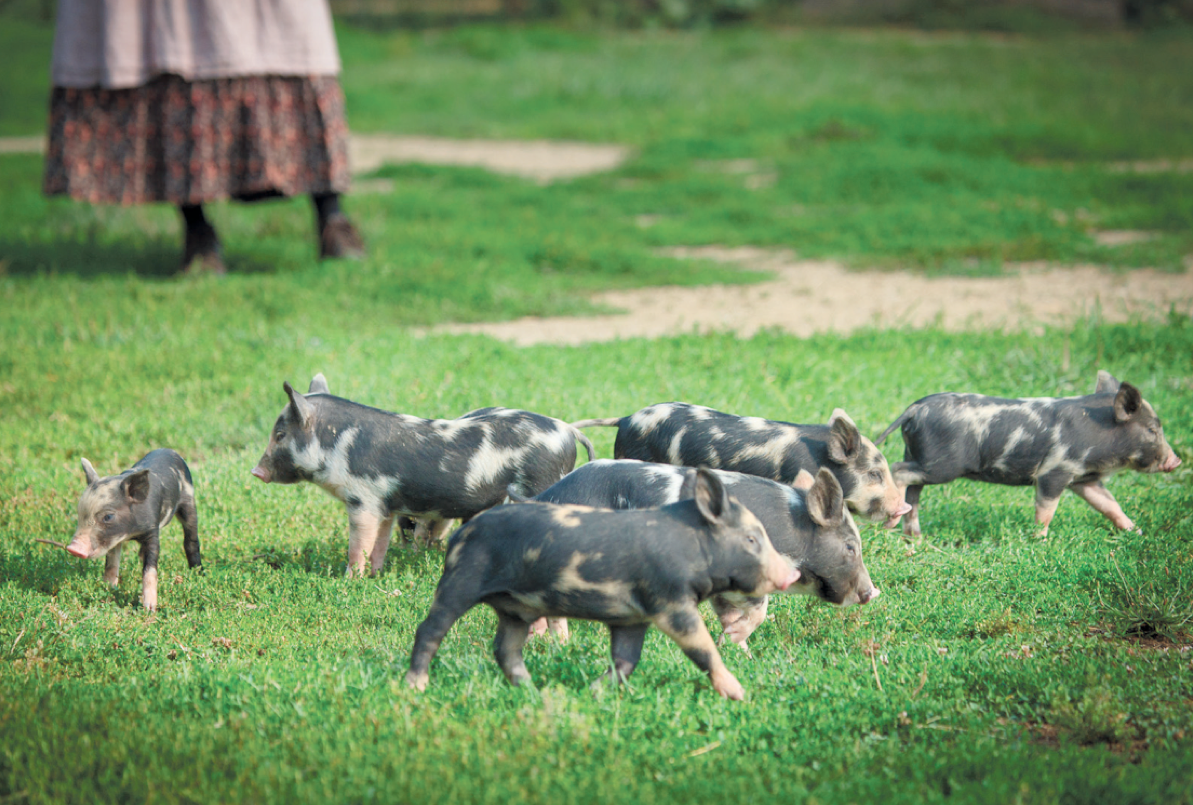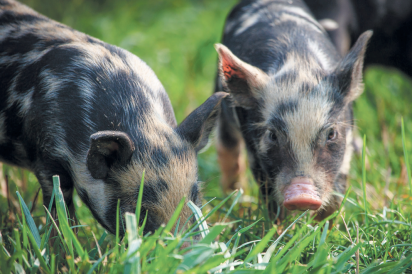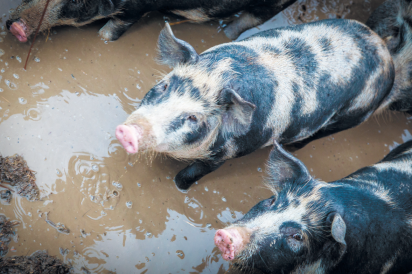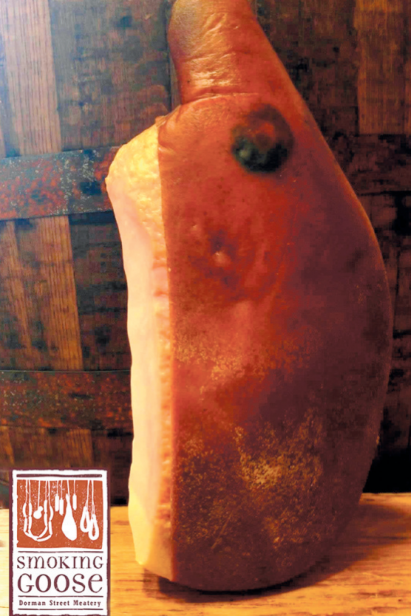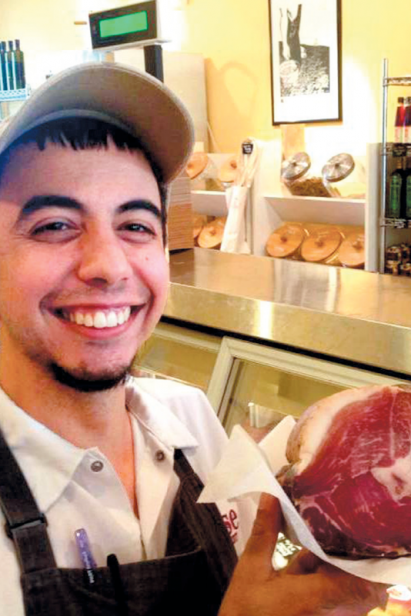Ossabaw Island Hogs: Heritage Breed Offers Time Travel by Taste
When I think of Conner Prairie Interactive History Park, what comes to my mind is a beautiful green lawn full of picnic blankets for Symphony on the Prairie, haunted hayrides and horse-drawn sleigh rides through 1836 Prairietown.
What many of us do not realize is that beyond those attractions is a historic hog farm that local chefs are sourcing for their menus.
In 2007, Conner Prairie acquired 10 Ossabaw Island Hogs, a historic breed of livestock that was introduced to the New World from Spain around the early 1500s. The hogs received their name due to their isolation on Ossabaw Island, a barrier island off the coast of Georgia. They are the closest representation of the kind of hogs that were present in the 1830s in Indiana as most of the hogs that were around at that time have died out.
Naturally, Conner Prairie has become a great new home for Ossabaw hogs, which can be nurtured and live their lives on the large grassy landscape of 1836 Prairietown.
In the 1500s, Ossabaw Island was an environment with high heat, humidity and seasonal scarcity of food. Adapting to their climate and surroundings, the hogs stored massive amounts of body fat flavored by their wild, foraged diet so it could be used for less fruitful seasons. This phenomenon is similar to that of non-insulin diabetes in humans, therefore making them prime for scientific research. Several universities, including IUPUI, have Ossabaw hogs for diabetic studies.
Because they thrive when not confined to small spaces, Conner Prairie offers them large lots to roam. Livestock Manager Kevyn Miller–the Noah to Conner Prairie's ark–tends to the hogs in the same way as Hoosier settlers did years ago.
"When faced with my own management problems," he says, "I am constantly asking myself 'How did they do it on the island?'"
Not only did the feral hogs adapt to their diets to the climate, over the course of centuries the hogs have physically changed as well. Isolation of living on the island caused insular dwarfism, though their size has little impact on their strength. Mature Ossabaw hogs tend to have big, square shoulders, a sign that their fat layer is developed and they're prime for the table. Chefs seek them out for picnic hams and luscious marbled cuts of meat.
Smoking Goose was aware of the culinary benefits brought by Ossabaw hogs and quickly worked to create delicious meat treats. From 12-month aged hams to Ciauscolo, a soft, spreadable salami, Smoking Goose has partnered with Conner Prairie to not only please our taste buds with limited-release porky treats but to help raise awareness about these historic hogs to the public.
Last spring, Chris Eley and the Smoking Goose team cured petite, bone-in Ossabaw hams under sea salt, cane & brown sugar, mustard seeds and black peppercorns before hanging them high for a light smoke over smoldering persimmon wood. After 11 months of aging, the smoked hams are ready to eat. Could you imagine the conversation around the Thanksgiving table if you prepared one of these for a real New World feast?
Similar to that of salami or a cold-cut meat, Ossabaw Brasolara was created with a splash of crisp, organic white wine and ground Ossabaw pork shoulder spiked with sea salt, black pepper, garlic and orange zest before cradling whole, hand-trimmed Ossabaw coppa inside natural beef casings. Curing and dry aging for over nine months creates an intense and sweet slice laced with citrus and Old World spice.
Currently available at Goose the Market is the Ossabaw Ciauscolo, a soft, spreadable salame traditional in Le Marche (the region that makes up the calf muscle of Italy's boot) made with the region's Verdicchio white wine, fennel pollen and fennel seed, as well as garlic. The 12-month dry-cured, bone-in hams are currently hanging and waiting patiently for a 2014 release date.
Interested in learning more about these Ossabaw hogs? Smoking Goose owner Chris Eley will butcher a whole Ossabaw hog, nose to tail, then make sausage start to finish at Ossabaw Fest, a project with Conner Prairie that is still in the works. Eley will prepare the meat for roasting and curing in front of an audience, putting a whole new meaning to live dinner theater.
HOW TO EAT IT:
In Italy, culatello–the cured, boneless heart of the ham–sidles up deliciously next to crystalline fractures of aged Parmigiano-Reggiano and classic mostarda (fruits and vegetables preserved under sweet-tart mustard oil). So we love to take those traditional pairings from The Boot and giving 'em an Indiana twist, just as Smoking Goose's Ossabaw Culatello brings Old World preparation to Indiana Ossabaw hogs raised just up the road.
Along with paper thing slices of Smoking Goose's Ossabaw Culatello, reach for Swiss Connection's Pazia, a Parmigiano-style, raw cow's milk cheese from the seventh-generation creamery in Clay City, Indiana. And in the corner of your plate, spoon a dollop of Preservation's Caramelized Pear & Cracked Pepper Jam, a brand new release from this Westfield, Indiana, family business that brings a sweet and spicy tingle to our tongues.
All products are available at Goose the Market.
A tip from behind the counter:
Goose the Market will be serving up hand-carved slices of Smoking Goose's Ossabaw Culatello at Conner Prairie's "Prairie Plates at Sunset" event on Thursday, June 19, 6:30–9:30pm. Tickets $45.
Take in the exquisite ambiance of the Conner Homestead at sunset as you enjoy small plates of meats, cheeses and more from Goose the Market, a selection of ciders and meads from New Day Meadery and minicake desserts from Sugar. After sunset, explore the beauty of the night sky with telescopes provided by Spaceport IN. A cash bar will be available for those who prefer other beverages.
Photos courtesy of Conner Prairie and Goose the Market


